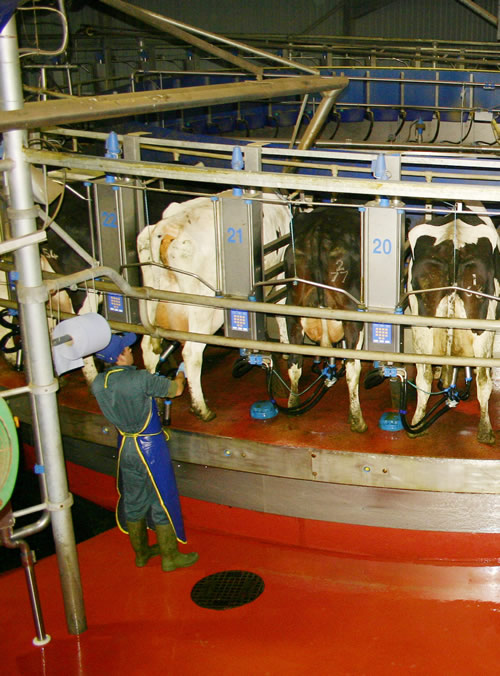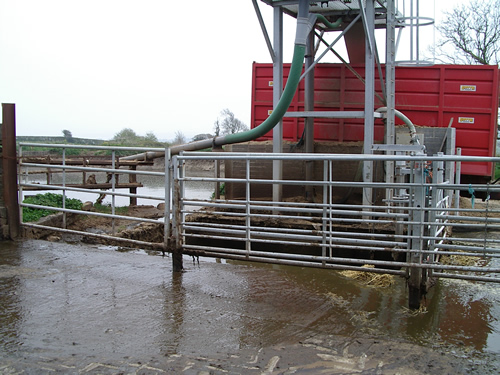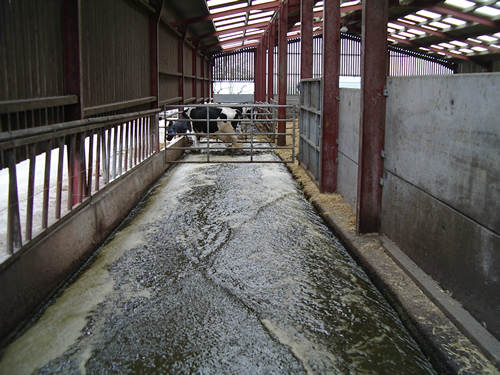
Astridge Farm is situated in the beautiful location of Pembrokeshire, Wales, in the United Kingdom. It is near the splendid beach and bay of Tenby. Nigel and Jill Batten have owned this 280 acre dairy farm since 1995. It was originally purchased by Nigel's father in 1969. Of the 280 acres only 190 are considered to be fertile land (photo 1). Previously, 280 cows were milked through a 14 point abreast parlour – taking 3 hours+ at each milking.
The time is now April 2008 and this Welsh dairy farm has changed and expanded to become one of the most modern and sophisticated available. Currently, 500 cows are milked through a fully automated and individually cow monitored Dairymaster 50 point rotary parlour (photo 6). This system has speeded up the milking process considerably to around 200 cows per hour.
New housing has been built and older buildings adapted for both cow and calf accommodation. A new Keenan TMR mixer, together with a new tractor and loader, has also recently been purchased. A large slurry separator enables the liquid left, once solids have been removed, to be used to regularly flush the passages in all the cow housing.
Dairymaster MooMonitors continuously record cow activity to provide accurate heat detection. The daily monitoring of all aspects of the 500 cows enables sound management decisions which, coupled with quality stockmanship, will produce best cost per litre of milk sold and maximum income per cow.

To maximise the overall management and production of the farm, Nigel and Jill have taken positive action to improve housing, monitoring, feeding and breeding.
Housing – cubicles and slurry management
Old buildings were adapted to provide updated calf housing and, especially, new cow cubicles. A new building was constructed to cope with the 500 cows over winter, with TMR rations fed under cover. Sand is used as cubicle bedding and changed weekly. This provides a clean and easy-to-manage bedding/floor system. Solids are separated from the slurry (photo 2). The liquid goes into lagoons for re-use as daily passageway wash water – a most effective way of cleaning and not having slurry disposal problems or environmental pollution issues (photo 3).
Monitoring – milk quality
The current herd average of 8200 litres per cow is expected to increase over the next 12 months. The milk quality is good at 4.1% butterfat, 3.25% protein, with SCC of fewer than 130,000 and Bactosan of under 50. The milk price of just below 27 pence per litre is expected to increase in the near future. This increase is needed to cover the increased costs of most items used on the farm.

The new parlour became fully functional in July 2005 (photo7). Each cow is fitted with a transponder so that she can be fed to yield with specialist parlour rations. Any feed not eaten and milk yield are recorded by the Dairymaster Milk Manager system at every milking thus enabling accurate daily management decisions. The cows are, without doubt, very contented in this new parlour, which provides easy milking and the opportunity for good cow observation. The system also includes semi-automatic footbaths which refill after every 100 cows. The low level of hoof problems is testimony to the effectiveness of this feature. Two three-way-drafting gates and retention bars give the facility for specific cow treatment after milking. From the parlour, one pipeline runs to a new 35,000 litre main bulk tank from which milk is collected every other day. There is a smaller divert milk line to a tank in the calf shed.
Forage and feeding
With only 190 acres of fertile land available it is clearly not possible to produce all the forage needed for the farm throughout the year. This year (2008), 350 acres of grass silage and a new 110 acres of maize silage will be produced by using additional local land. The grass silage will be treated with an additive that has proven useful in controlling aerobic spoilage at the clamp face.
The large TMR mixer will enable quicker and more effective production of three revised rations including, in particular, the addition of straw for the dry cows. As well as the forages, other materials will include: by-products; soya hulls; and molasses. The high yielders are fed TMR rations in the new housing. It is expected that these new rations will not only increase yields but will improve feed conversion and assist maintenance of good herd health.
Herd maintenance and breeding
Replacement cows, two to three weeks after first calving, are successfully purchased from the local Carmarthen market. This allows Astridge Farm to concentrate on the milking cows and beef calves. Five Belgian Blue bulls have replaced ten Hereford bulls and are used with the low yielders to produce top quality calves for beef production. These calves may be fed milk diverted from the dairy or milk substitute. In total they are fed at a maximum six litres of liquid per calf per 12 hours. The feeding is controlled by a transponder on each calf. A coarse mixture ration is fed ad-lib until sale of the calves at around five weeks of age. These calves are worth far more than those from the Herefords. Bull calves are worth about £50 more each than heifer calves. Superb batches of calves housed on plenty of clean straw help to produce a good income per cow (photo 4).
Herd Calving Index
Cow activity is a sound indicator of heat detection. Visual observations of bulling with manual recording will detect only 40% to 60% of cows on heat at best. Dairymaster MooMonitors fitted to Nigel and Jill Batten's 500 cow herd at Astridge Farm are providing continuous data and a 95%+ accurate heat detection rate wherever the cows are on the farm. Comparison charts from visual only, visual + monitor and now monitor only clearly demonstrate that around 50% of cows on heat are not detected by visual only. An added advantage of these Monitors is that of being alerted promptly to certain illnesses or just to happy cows on spring grass in the sunshine!! (April 2008)
The monitors are fixed to a collar with a weight below the neck to hold them in place (photo 5). The monitors are robust, well accepted by the cows and continuously record activity data on a PC or mobile phone. The data can be downloaded and stored by the operator at set intervals. The bar chart will show activity patterns, heat detection and clear 21 day cow cycle patterns. AI from Alta is used at the optimum time for the high yielders, as is pregnancy scanning and the ability to draft the cow, after milking, for other reasons. A separate chart shows inseminations, pregnancy and calving dates.
The Overall Herd Calving Index on this farm is confidently expected to reduce from the current 400 days to 380 days in 12 months time; in addition there will be a reduction in veterinary costs. Mr Batten considers that all herds of 300 cows or more would benefit from having MooMonitors fitted as a reliable management tool to maximise breeding efficiency, which will contribute significantly to a herd's financial status.
In conclusion
Nigel and Jill Batten's investment and commitment to future profitable milk production is an encouraging example to dairy farmers of the future anywhere in the world. Their overall objectives are to use top quality products and systems with quality back-up, to do the job well but make life as easy as possible. The investments in the last three years and such a positive attitude will surely achieve these goals and bring well deserved rewards.
